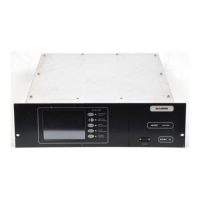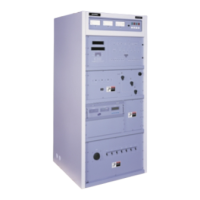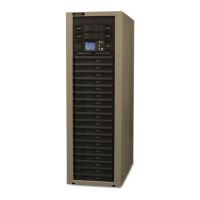Isolate the problem further as outlined
below. If a change in antenna impedance is
indicated, it may bedue to afailed capacitor
or other change in the antenna system.
Whether to re-tune the transmitter should
dependon the extent and natureof the prob-
lem.
If there is a change in antenna impedance
due to a change in ground conductivity (re-
sulting from rain), it would be permissible
to re-tune the transmitter to match it to the
new load impedance.
However, if the impedance change is due
to a failing capacitor in the antenna system,
it would be best to avoid readjusting the
transmitter tuning. Re-tuning the transmit-
ter to match the failing part would probably
accelerate the failure.
4.7.6.2. Antenna Problem
Connect the transmitter into a dummy
load if one is available to determine if the
faultis withthe antennasystem orthe trans-
mitter. If the antenna system is a directional
array, the VSWR problem may be found to
be peculiar to one attenna pattern only.
4.7.6.3. Output Network
A faulty capacitor orbrokenconnectionin
the Output Network may be the cause if the
transmitter also does not operate properly
into a dummy load. A thorough inspection
of theOutput Networkmay reveal the prob-
lem. Look for any loose or burned connec-
tions,and anyphysicalsignsofstressonany
of the capacitors.
WARNING
REMOVE ALL AC POWER AND DIS-
CHARGE ALL POINTS WHERE RESID-
UAL VOLTAGE MAY REMAIN BEFORE
PERFORMING AN INSPECTION OF THE
OUTPUT NETWORK.
WARNING
THE VSWR PROTECTION CIRCUIT
SHOULD NEVER BE DEFEATED AS A
MEANSOFGETTINGTHETRANSMITTER
BACK ON THE AIR.
4.7.7. VSWR Trips With High Levels
Of Modulation and High Power
4.7.7.1. Improper Tuning and Loading
If this problem is encountered in the first
hours of operation, there may be a setup
problem. Refer to the initial turn on proce-
dure and maintenance section where PA
Tuning and PA Loading are described.
Check the VSWR Detector Null reading
on the Multimeter. This reading should be
zero. An increase in the VSWR Detector
Null reading would indicate that the load
impedancehaschangedfromtheinitialtune
up or that the transmitter tuning or loading
has changed (either through front panel ad-
justment or by a failure of an Output Net-
work component).
4.7.7.2. Antenna
Ifa dummy loadis available, try operating
the transmitter into it. There should be no
significant Detector Null reading when op-
erating into the dummy load, assuming the
antenna impedance is close to the dummy
load impedance. If the VSWR Detector
Null reading reads upscale, there is prob-
ably a problem in the antenna system.
4.7.7.3. Output Network
If the VSWR problem still exists when
operating into the dummy load, there may
be a faulty capacitor or connection in the
transmitter’s Output Network. Check the
output spark gap on top of the Loading
control to see if it is shorted, and C3 and C4
in the Output Network. These are the com-
ponents which would affect the impedance
seen by the VSWR Detector.
WARNING
THE VSWR PROTECTION CIRCUIT
SHOULD NEVER BE DEFEATED AS A
MEANSOFGETTINGTHETRANSMITTER
BACK ON THE AIR.
4.8. Symptom: Remote Control
Functions Do Not Work
4.8.1. Possible Causes
4.8.1.1. Remote/Local Switch
Check to see that the REMOTE/LOCAL
switch on the Controller is in the REMOTE
position.
4.8.1.2. Remote Control Improperly Wired
Review the installation instructions in
Section II. Each remote control input of the
transmitter isactivatedby a momentary clo-
sure to ground.
4.8.1.3. Remote Control Unit Not Func-
tioning
Check the remote unit to see that it is
providing closures to the transmitter. You
might use a clip lead to momentarily pro-
vide the contact closures at the remote con-
trol unit to see which piece of equipment is
at fault.
4.8.1.4. Ribbon Connectors Loose
Ensure that the ribbon connectors on the
Interface board and the Controller are fully
seated.
There may be a failed optical isolator on
theControllerboard.RefertotheController
troubleshooting procedures in Section J.
4.9. Causes for a PA Volts/PA
Amps Ratio Change
This discussion covers causes which
might not be apparent based on front panel
indications and readings.
4.9.1. No +20 Volts to PDM Amplifier
Loss of the +20 volt supply to a PDM
Amplifier should cause one or more PDM
Fault LED’sto illuminate. To be certainthis
is not the problem, measure the voltage on
the fuses on each PDM Amplifier to make
sure +20Vdc ispresent. Ifnot, trace+20Vdc
back to its origin via the Interface board.
4.9.2. Impedance Change
The Output network can cause a change
in the PA Volts to AMPS ratio. ThePA volts
to PA AMPS ratio is affected by the imped-
ance seen by the PA module. If the imped-
ance seen by the PA module changes,
whetherfromanantennaimpedanceshiftor
fromadjustingthe frontpanelTUNINGand
LOADING controls, the PA VOLTS/PA
AMPS ratio will be affected. Small changes
will only cause a ratio change. Large
changes will cause VSWR overloads.
Check the Detector Null reading on the
multimeter. It should be zero.
If the Detector Null reading is zero, but
you suspect an Output Network failure, it
will be in the L1/C1 and L2/C2 sections.
This circuitry is ahead of the VSWR sens-
ing.
A failure of C1 will shift the PA Tuning.
Rotatethe PA Tuning controltopeak thePA
current. The PA Amps should peak within
threesmalldivisionsonthePA Ampsmeter.
If the PA Tuning has to be changed by a
considerableamounttopeakthePAcurrent,
it is indicated that there is a problem with
L1/C1. Inspect the C1 capacitors for any
physical signs of stress.
A failure of C2 will shift the PA load
resistance. You can measure the impedance
looking into the Output Network to deter-
mine if there is a problem with L2/C2. This
is done by connecting an RF bridge in place
of the A1 output connection. An RF resis-
tance significantly different than the test
datavaluefor“CombinerLoadImpedance”
wouldbeanindicationofanL2/C2problem
if the impedance at the back end of L2 is
verified to be 50 ohms j0.
The parallel resonant frequency of L2/C2
may also be checked per the procedure in
Section III (Maintenance).
4.9.3. PA Failure
Although a rare condition, an open PA
transistor could cause a ratio change with-
out blowing the associated fuse. Oneway to
isolate this problem would be to disconnect
PA transistor pairs by removing fuses to see
Rev. T: Jan. 1996 888-2314-001 4-3
WARNING: Disconnect primary power prior to servicing.
